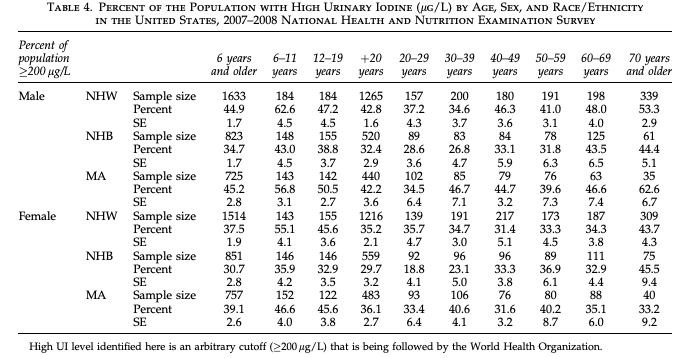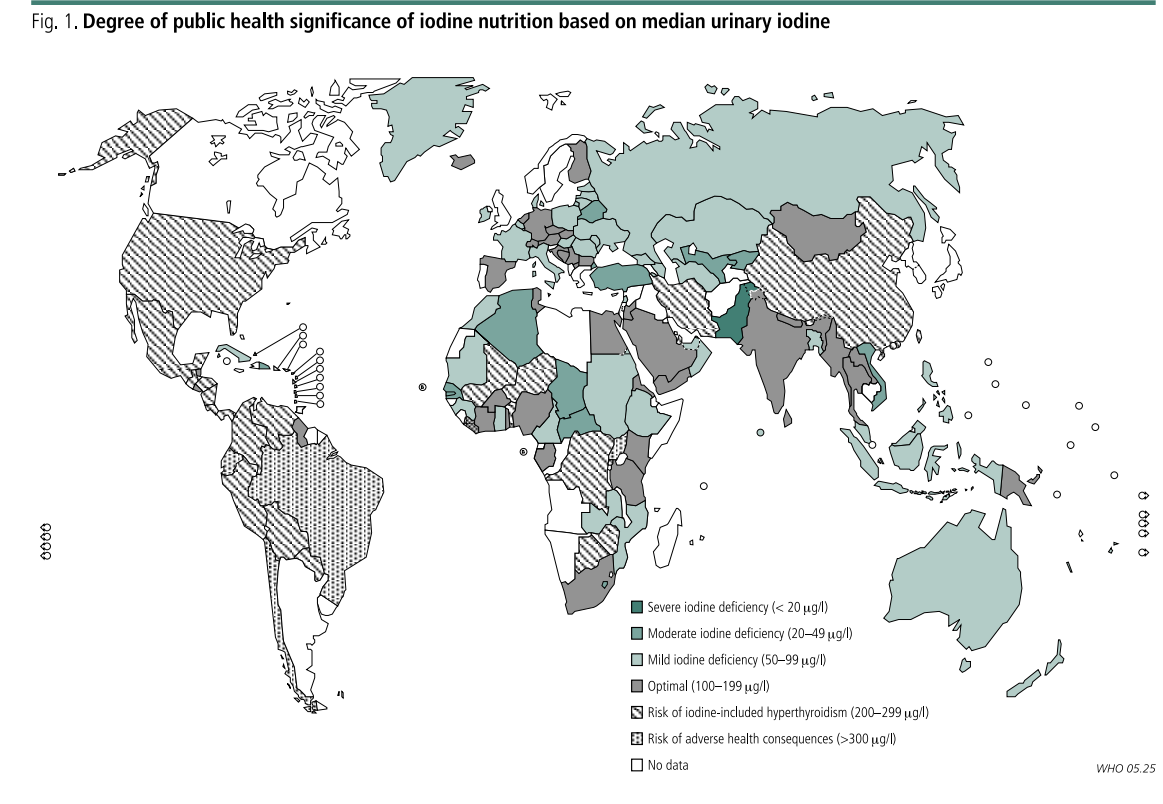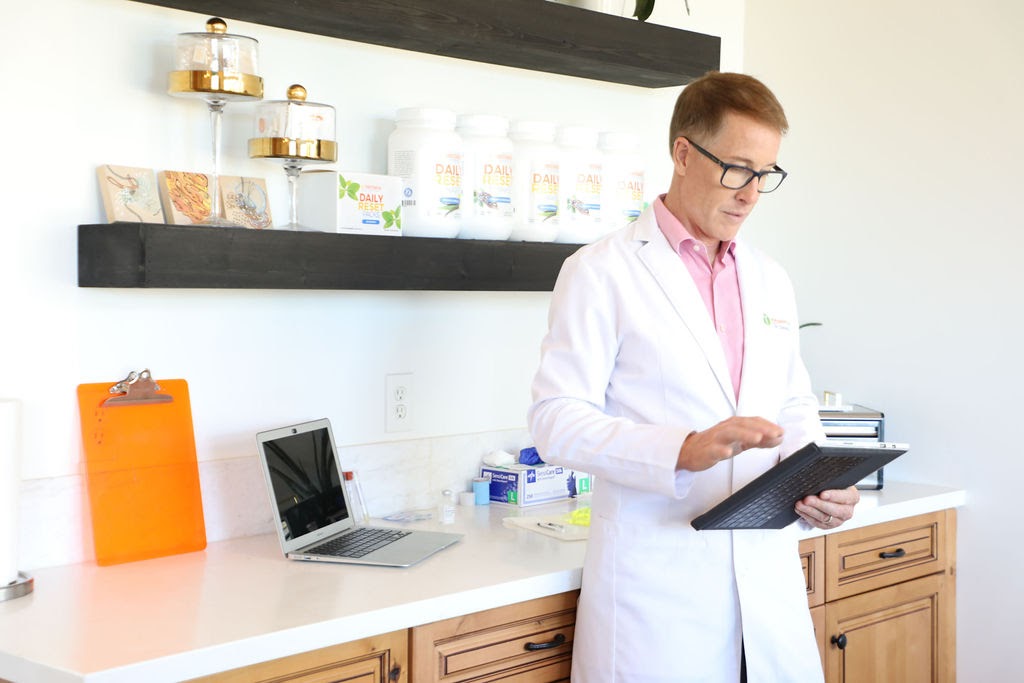Iodine is such a source of confusion. You used to hear about getting too little and now there is more talk about getting too much.
So how much do we get in the modern world?
Today, I want to dive into how much iodine we typically consume, and what it means for our overall health. I’m sure you’ll find it interesting.
The most important thing to note is that this is incredibly tricky. In fact, you’ll likely see some data arguing that there are people in the United States who get too little, in pockets in the world that get too little, and yet there are also concerns about getting too much.
So, it depends a lot on subpopulation, which is what I want to talk about today. Let’s dive into that right now…
Subpopulations with High-Iodine Status
We can see that some subpopulations in the US, like those who are pregnant or lactating, can be low in iodine (around 16% of pregnant women may be low in iodine).1
By and large, these are people who are on diets that are rather restrictive already, as well as not taking multivitamins that include iodine.
The pitfall here is that multivitamins with iodine often have unsafe or unpredictable amounts in them.
During pregnancy, and in the first several weeks, the baby cannot make their own thyroid hormone. Therefore, the mother needs to make extra in order to support the baby in the womb. This helps run the baby’s metabolism.
Key Insight: That extra hormone requires a little extra iodine, up to twice as much as they would otherwise need. When things work well, an adequate, healthy amount allows that to occur seamlessly and with little drawbacks.
Non-Pregnant Subpopulations
So, let’s look at things apart from being pregnant.
The following slide is a great way to illustrate the point that I want to make…

This is the percentage of the US population that has unsafe or high levels of iodine. This is broken down for age, gender, and ethnicity.
If we take a look at these raw numbers, there is both the sample size and the adjoining percentage. What this points out is that there are many ages where we can see half of them with unsafe levels of iodine.
Key Insight: The range exists somewhere between the high 20’s to the low 60’s in a wide range of demographics.
Per age and ethnicity, up to 55.1% of females and 62.6% of males are ingesting iodine levels that the World Health Organization considers unsafe.2
When you crunch all of that together, the overall averages of the US population are somewhere in what we might call the “high-normal” range (Read More: How Much Iodine Do You Really Need?).
How Much Iodine Are We Really Getting?
The next thing I want to share with you is a handy map from the World Health Organization (WHO). It illustrates the consumption of iodine around the world…

They have recognized that some parts of the world have severe iodine deficiencies and that other places are at risk for adverse health effects due to too much iodine.
We can see from the above map that the United States, along with Central and South America, are at risk for adverse health consequences due to higher levels of iodine.3
The areas that have had severe iodine deficiencies have changed so much in the not-too-distant past. Thankfully, the number of countries that were deficient has gone from 200 (in the early 90’s) down to around 5 of them. That is a great improvement.4
Bottom Line: As a worldwide community, we should be striving toward no countries having to deal with iodine deficiencies. It is tragic, and we need to work against it.
Why Is Iodine Deficiency Bad?
As I mentioned, a country that is deficient in iodine can result in some severe problems for the entire population. These can include:
- Congenital Hypothyroidism
- Developmental Delays (Cognitive Impairment)
That’s the big paradox around iodine, though, and really the most important lesson surrounding it. You can’t have too little, and you can’t have too much. It needs to be exactly right.
And even the slightest but too much can see different problems emerge…
Why Is Too Much Iodine Bad?
One of the most notable issues of too much iodine is thyroid disease.
In fact, in the US, the rates of autoimmune thyroid disease, in counties that track it, went 52 times (not percentage points) higher before and after iodine fortification.
That is because there is an incredibly narrow window for intake, and it makes iodine unique when compared to just about any other nutrient out there (Read More: How To Enjoy A Low-Iodine Diet).
Bottom Line: Thankfully, now, in the US we are no longer really at risk for too little iodine. Instead, we should be concerned about getting within that window (without going over).
While pregnant women who are on very restrictive diets are at risk, that is about the only group. We have many more subpopulations who are at risk for excess iodine, and that is where the WHO has categorized the United States as exactly that.
Overall, our entire nation is at risk for excess amounts of iodine.
What Should Be Your Takeaway About Iodine?
The major thought about iodine is that it is all about having enough, not too much and not too little, to help support the health of your thyroid (and your overall health, too).
We also want to avoid having radical fluctuations of iodine. We see that even changes within what should be a safe range, these can still unmask or unleash thyroid disease in our bodies.
Earlier, I discussed how we have had this large uptick since we began fortifying water with iodine, but the same thing has been evidenced in other nations.
Austria, for example,has seen a large uptick in autoimmune thyroid disease between 1979 and 2009.5 This kind of increase in hypothyroidism is definitely of concern to us.
What Can You Do About Iodine?

Part of this paradox is because iodine is a nutrient that is used in amounts that are much higher than those we would find in our diets. The body, therefore, has to store it and concentrate it.
That is all well and good, but when our intake fluctuates the concentrating mechanisms can go awry. They can concentrate too much, and they can make it to where the gland is just irritated and has more free radical damage and disease sets in.
In the United States, our overall intake is above a safe range, and it is very pronounced in some subpopulations much more than others.
Key Insight: This is important because it should help you identify whether you fit in that population and if you have cause for concern.
Dial-In Your Iodine & Thyroid Health Today
The best part about realizing just how much iodine you’re getting is being able to get it right.
When you have the chance to dial in your iodine, it can help reverse thyroid disease, stabilize those who have had progressively lost thyroid function, and for many we can see better overall health and less symptoms.
Start by taking the Thyroid Quiz today (Click Here: Take The Quiz Right Now). It can help you determine the status of your thyroid, what might be going on, and action steps you can take right now to preserve it’s health.
Resources
1 – https://www.ncbi.nlm.nih.gov/pmc/articles/PMC6373336/
2 – http://www.ign.org/cm_data/2011_Caldwell_Iodine_status_of_the_US_population_NHNES_2005_06_and_07_08_Thyroid.pdf
3 – https://www.who.int/bulletin/volumes/83/7/518.pdf?ua=1
4 – https://www.ncbi.nlm.nih.gov/pmc/articles/PMC4139880/
5 – https://sci-hub.se/10.1007/s00428-011-1130-x

1. Schedule a Thyroid Second Opinion with me, Dr. C, Click Here for Details
2. Download and use my Favorite Recipes Cookbook Here
3. Check out my podcast Medical Myths, Legends, and Fairytales Here
Dr. Alan Glen Christianson (Dr. C) is a Naturopathic Endocrinologist and the author of The NY Times bestselling Adrenal Reset Diet, The Metabolism Reset Diet and The Thyroid Reset Diet.
Dr. C’s gift for figuring out what really works has helped hundreds of thousands of people reverse thyroid disease, lose weight, diabetes, and regain energy. Learn more about the surprising story that started his quest.


